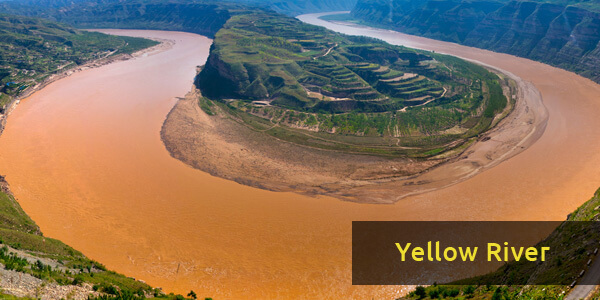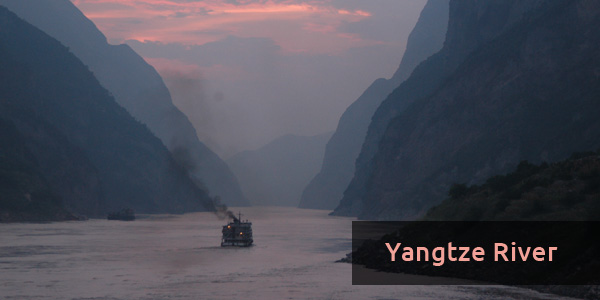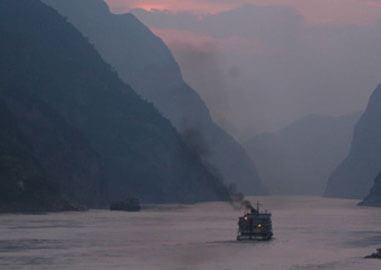
Rivers in China Facts
Posted By MariaChina is a country with numerous rivers flowing through it which are over 50,000 in number. These important waterways serve the country in various ways. Some are used to generate hydroelectric power, some for irrigation and navigation while others provide breathtaking scenic beauty to attract tourists. The course of most of the rivers in China takes an eastward or southern direction, emptying into the ocean. Therefore, the huge span of river valleys occupies almost two-thirds of the country’s territory.
The following discussion provides information about the most important rivers in China.
Yangtze River
Popular as Chang Jiang in China, Yangtze is the longest river of the Asia and holds the title of the third largest river in the world. In addition, Yangtze makes another world record by having the highest source – 5,000 meters above sea level – among all the major rivers of the world. It begins its long journey from Qinghai where the river emerges from the glaciers of Qinghai-Tibet plateau. The river covers a distance of 6,300 kilometers and finally empties into the East China Sea. Through its course, Yangtze drains one-fifth of the country’s land with a basin covering 1,808,500 square kilometers of area.

The Yangtze River is surrounded by beautiful scenery which is one of the major attractions for tourists visiting the People’s Republic of China. It emerges from remote mountains and passes through canyon gorges as well as areas of connecting lakes and other interesting waterways. The river has been serving as a source of water and fish, a means of transport and a boundary for thousands of years.
More interesting information about Asia’s longest river is discussed below.
- Situated on the upper river is the world’s deepest gorge. It is known as Tiger Leaping Gorge with mountains as high as 4,000 meters.
- The world’s largest dam, the Three Gorges Dam, is built on the Yangtze River.
- Several rare and endangered organisms are found in the Yangtze. These include the finless porpoise and the Chinese alligator.
- Eight major tributaries join the river at different points and add to its huge volume.
- It is the longest river with a course of flow passing through a single country.
Yellow River
The second longest of the rivers in China, the Yellow River, flows for 5,464 kilometers. In China, the river is popularly known as Huang He. It carries immense historical significance and is also known as the “cradle of Chinese Civilization”. The river’s basin, covering an area of 752,000 square kilometers, is where the ancient Chinese civilization was born. According to the records of early Chinese history, it was an extremely prosperous region.

The Yellow River emerges from the Bayan Har Mountains in the province of Qinghai. During its course, it crosses nine different provinces of the country and meets its fate in the province of Shandong where it flows into the Bohai Sea.
Go through the following interesting facts about the Yellow River.
- The river has three major tributaries. River Fen joins it from the left while the Tao River and the Wen River form the right tributaries.
- The river’s average discharge is 2,571 cubic meters per second.
- The basin area of the Yellow River houses records of the Neolithic age, the Bronze Age as well as the Iron Age.
- The river offers relics of the ancient Chinese culture as well as wonderful natural beauty for tourists.
- Frequent floods and natural changes in course have ruined the once prosperous river basin. It has, therefore, earned a pitiful title: China’s Sorrow.
Heilongjiang River
Heilongjiang ranks as the world’s tenth longest river with a length of 4,444 kilometers. Also known as River Amur, it carries political importance since it forms the border between the Northeastern part of China and the Far East Russia. It emerges from the hills of Manchuria where the Shika River and Ergune River converge together to form the Heilongjiang River. From there, it flows through a winding course to reach its final destination – the Strait of Tartary in the Pacific Ocean.
Find out more about this interesting river in the following facts.
- Heilongjiang means the Black Dragon River.
- The river’s basin area covers 1,855,000 square kilometers.
- Heilongjiang is a province in China situated at the southern bank of the Amur River. The province was named after the river.
- The name Sahaliyanula was used by the Manchu and Ta-tsing Emperor who deemed the river sacred.
- The river is joined by two hundred tributaries.
- Amur’s basin area is the tenth largest in the world.
Sungari River
Known as Songhua Jiang in China, the river is the major tributary of Heilongjiang. It originates from the Changbai Mountains and flows through the Chinese provinces of Jilin and Heilongjiang. Through its course, Songhua Jiang covers 1,434 kilometers.
Go through the following informative facts about the Songari River.
- The river joins Heilongjiang below Tongjiang Town in China.
- The drainage area of Songari is 550,000 square kilometers.
- The river is used to generate hydroelectric power through a dam at Fengman. This reservoir forms a retention lake which is 200 kilometers long.
- The river freezes during late November till March.
- During its course of flow, Songari River passes three cities in China – Jilin, Jiamusi and Harbin.
Pearl River
In China, the Pearl River is known as Zhu Jiang. It is also referred to as Gangdong or Canton River. It is an important river system in the southern part of China. The system consists of watersheds of Xi Jiang, Bei Jiang and Dong Jiang – the West, North and East Rivers respectively. These rivers are deemed as the tributaries of Zhu Jiang as they all share the Pearl River Delta. The following facts reveal more information about this river.
- The system forms the third longest river in the country with 2,400 kilometers of length.
- Pearl River flows throw two countries and eight different states. The two countries are China and Vietnam.
- The final destination of the river is the South China Sea.
- Pearl River’s basin covers 453,700 square kilometers of area.
- The part of the river flowing through Guangzhou contains shells at its bottom which are pearl colored. This is what gives the river its name.
- The Pylons of Pearl River Crossing consist of a power line of 500 kV. The pylons rank as the tallest in the world.
Tsangpo-Brahmaputra River
One of Asia’s major rivers, Tsangpo-Brahmaputra River crosses international borders and flows through three countries – China, Bangladesh and India. The total length of the gigantic waterway is 2,900 kilometers. It emerges from the Himalayas of Tibet and flows into the Bay of Bengal to join the Indian Ocean.
Here are some informative facts about Tsangpo-Brahmaputra River.
- In China, the river is known as Yarlung Zangbo Jiang.
- Brahmaputra is a Sanskrit word which means the son of Brahma.
- The source of the river is the famous Chemayungdung Glacier in the Himalayas.
- The huge basin area of the river covers 651,334 square kilometers.
- On average, the Brahmaputra River discharges 19,300 cubic meters per second.
Mekong River
The Mekong River is one of the longest rivers in Asia. It flows through six different countries of the southeastern part of continent and covers a length of 4,350 kilometers. It emerges from Lasagongma Spring in the Tibet Plateau and flows to the Mekong Delta. Its huge basin area covers 795,000 square kilometers and is home to around sixty million people. The following facts provide more information about the river.
- The Mekong ranks as the world’s 12th longest river.
- The river is known as Lancang Jiang in China.
- The six countries situated along the course of the river are: China, Burma, Thailand, Vietnam, Laos and Cambodia.
- The river was first discovered in 1540 by a Portuguese named Antonio de Faria.
- The Mekong River is important in many ways for the countries it passes through. It is a source of eighty percent of protein food in Cambodia and half of the irrigation water in Vietnam.
- An endangered species, the Irrawaddy Dolphin, is found in the river along with other interesting organisms, such as the Siamese crocodile and Freshwater Stingray.
Ruo Shui
Although shorter than the other major rivers of China, Ruo Shui is an important river system which flows through the northern part of China. It emerges from Qilian Mountains and flows for 630 kilometers. Its course takes the river to the Gobi desert towards its mouth located in Badain Jaran Playa.
The following facts provide more information about the Ruo Shui.
- The river is also known as Etsin Gol or the Ejin River.
- During its course, the river crosses two states of China – Gansu and Inner Mongolia.
- The river’s basin stretches over an area of approximately 78,600 square kilometers.
- The Ruo Shui forms an inland delta which consists of one of the world’s largest alluvial fans.
The above discussion has provided information and interesting facts about some of the most popular and important rivers of China. The country abounds in waterways which provide its population with multiple precious resources.
China Country - Latest Articles

Chinese Culture Facts about Food
Posted By KathleenChina's traditions vary greatly from those followed in the western world. Be it family...

The Interesting Facts about Culture and Traditions in China
Posted By John DoeCulture in China is extremely interesting and intriguing. It differs immensely from the customs...

Rivers in China Facts
Posted By MariaChina is a country with numerous rivers flowing through it which are over 50,000 in number...
